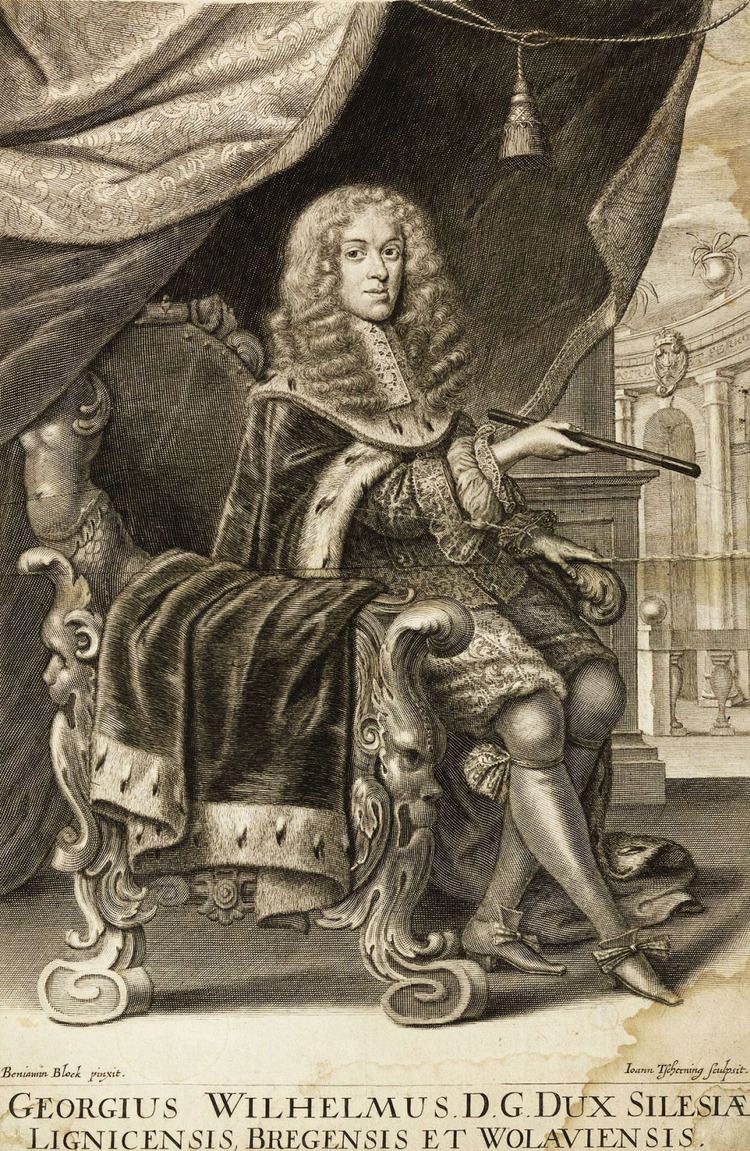Noble family House of Piast | Name George Duke | |
 | ||
Born 26 September 1660Olawa, Silesia ( 1660-09-26 ) Parents Christian, Duke of Brieg, Louise of Anhalt-Dessau Grandparents John Christian of Brieg, Dorothea Sibylle of Brandenburg, John Casimir, Prince of Anhalt-Dessau People also search for | ||
George William of Legnica,or George IV William (German: Georg Wilhelm; Polish: Jerzy Wilhelm legnicki; 29 September 1660 – 21 November 1675) was the last Silesian duke of Legnica and Brzeg from 1672 until his death. He was the last male member of the Silesian Piast dynasty.
Contents
Descendance
George William was the eldest but only surviving son of Duke Christian of Legnica-Brzeg (1618-1672) by his wife Louise (1631-1680), a daughter of Prince John Casimir of Anhalt-Dessau. He had three siblings:
As the only surviving son, George William was the sole heir to his father's possessions. Duke Christian of Legnica-Brzeg spent many years in exile in Poland and in the Duchy of Prussia during the Thirty Years' War, after George William's grandfather Duke John Christian of Brieg had fallen out of favour with the Habsburg emperor Ferdinand II.
After the abdication of King John II Casimir Vasa of Poland, Duke Christian put forward his own candidacy for the Polish throne; in order to win the affection and support of the old nobility, he initially wanted to give his newborn son an old Piast name (like Mieszko or Boleslaw); however, the Calvinist clergy of his duchy opposed this, maintaining that the idea could bring the return to paganism over Poland. The duke, however, saw to it that his son spoke Polish and wore Polish clothes.
Life
The deaths in 1663 and 1664 of his paternal uncles Duke George III of Brieg (1611–1664) and Duke Louis IV of Legnica (1616–1663) without surviving issue left him as the only heir of his father in the still vast Duchy of Legnica-Brzeg. As a result, since his early years, George William received a careful education. During his upbringing, he was put in the hands of Count-Marshal August Friedrich Bohne, and the personal doctor Henry Martini. It was during this first period of his education that he acquired an excellent knowledge of German, French and Latin, but he was able only to speak in Italian, Spanish and Polish; he was also educated in theology, philosophy and rhetoric.
When his father died in 1672, the then twelve-years-old George William succeeded him as Duke of Legnica and Brzeg; during his minority, the regency was held by his mother, Dowager Duchess Louise who was the regnant Duchess of Wolow and Olawa as her Oprawa wdowia(Wittum). Fearing claims raised by Emperor Leopold I, Duke Christian had devised by will that his son was formally under the tutelage of his maternal uncle Prince John George II, Prince of Anhalt-Dessau and Elector Frederick William of Brandenburg. The day before his father's death, Louise sent her son to study at the Viadrina University in Brandenburgian Frankfurt an der Oder, considered as an act of mistrust by the Imperial court. On the other hand, the regency of the dowager duchess faced the opposition of the Protestant states of Legnica-Brzeg, thanks to her increasingly open support for the Catholic faith; a major scandal occurred when the young duke's sister Karolina secretly married Frederick, a member of the aristocrat Catholic family of Schleswig-Holstein-Sonderburg-Wiesenburg.
The Brandenburg elector reached an understanding with the Habsburg emperor, and in 1673 George William returned to Brzeg, where he received the homage by the estates. On 14 March 1675 the young duke could take formal possession of the government of his lands, after he went to the Imperial court in Vienna making his solemn homage to Emperor Leopold I, who confirmed his coming of age and the succession to his father's lands. Immediately after the beginning of George William's personal rule, Duchess Louise was forced to give up her land of Wolow. The announcements of the start of a good and prosper government by George William were stopped with the sudden death of the duke on 21 November 1675. The cause of his death was a strong fever, developed shortly after his return from a hunt, the first sign of smallpox. The duke was buried in the church of St. John in Legnica, alongside his father, where his mother had a mausoleum built.
Legacy
Upon his death, the Duchy of Legnica-Brzeg reverted to Emperor Leopold in his capacity as Bohemian king and ruler over the Lands of the Bohemian Crown within the Holy Roman Empire, which for centuries were integral part of the Austrian Habsburg Monarchy. Leopold took up the government by a Landeshauptmann deputy, despite the claims of George William's morganatic uncle Count August of Legnica. Duchess Louise retained her lands of Olawa until her death in 1680, when they were also incorporated into the Bohemian lands.
The independent Masovian Piasts had died out in 1526, while the Duchy of Teschen (Cieszyn) line died out in 1653. George William was therefore the last ruling member of all the Piast dynasty, which finally became extinct with the death of his only surviving sibling, Karolina, in 1707. The term "Piast dynasty" was first used by the Polish historian Adam Naruszewicz in his books History of Poland, which he started in 1779. On George William's burial crypt a text was carved referring to him as the last of the Piast dukes of Silesia, who are since the 17th century referred to as "Silesian Piasts".
